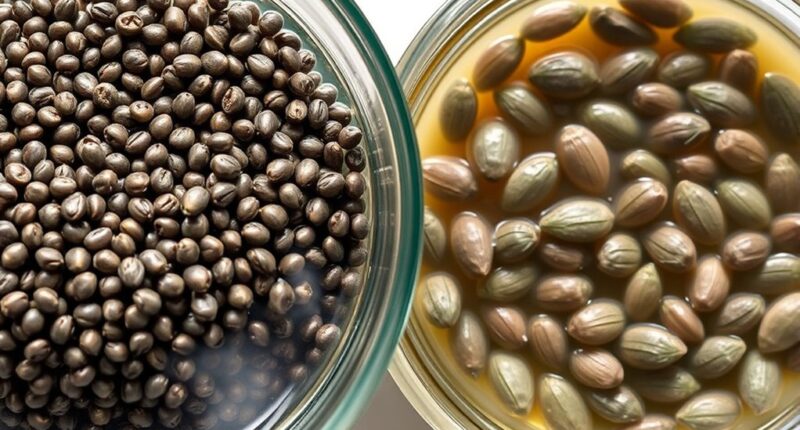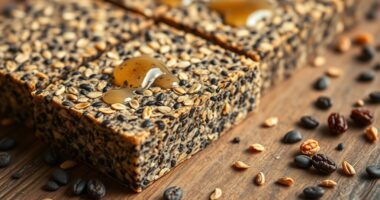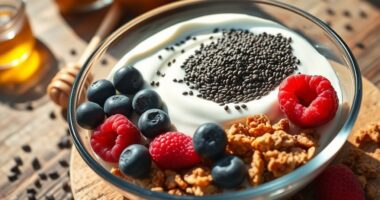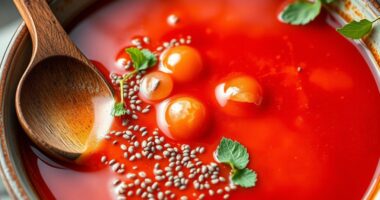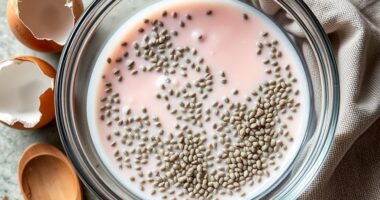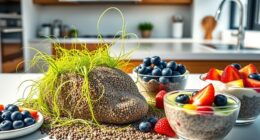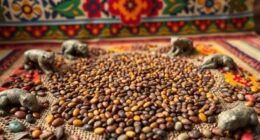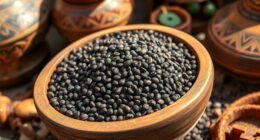If you’re choosing between chia and basil seeds for drinks and desserts, you’ll find that chia seeds add a chewy, gel-like texture once soaked, thanks to their high omega-3 and fiber content, making them great for nutritional boosts. Basil seeds, on the other hand, swell quickly into a jelly-like consistency and are perfect for soothing, invigorating beverages with visual appeal. To understand which suits your recipes best and how to use them effectively, keep exploring their unique features.
Key Takeaways
- Chia seeds form a gel-like texture when soaked, adding chewiness, while basil seeds develop a jelly coating for a smooth, thick consistency.
- Chia seeds are nutrient-dense, rich in omega-3s and fiber, enhancing health benefits in drinks and desserts; basil seeds mainly provide hydration and texture.
- Chia seeds have a mild flavor that blends seamlessly, whereas basil seeds add a slight herbal note and visual appeal to beverages and jellies.
- Soaking chia seeds takes longer (about 15-30 minutes), while basil seeds swell quickly in just a few minutes.
- Use chia seeds for nutritional enrichment and basil seeds for aesthetic, soothing, and textural effects in recipes.
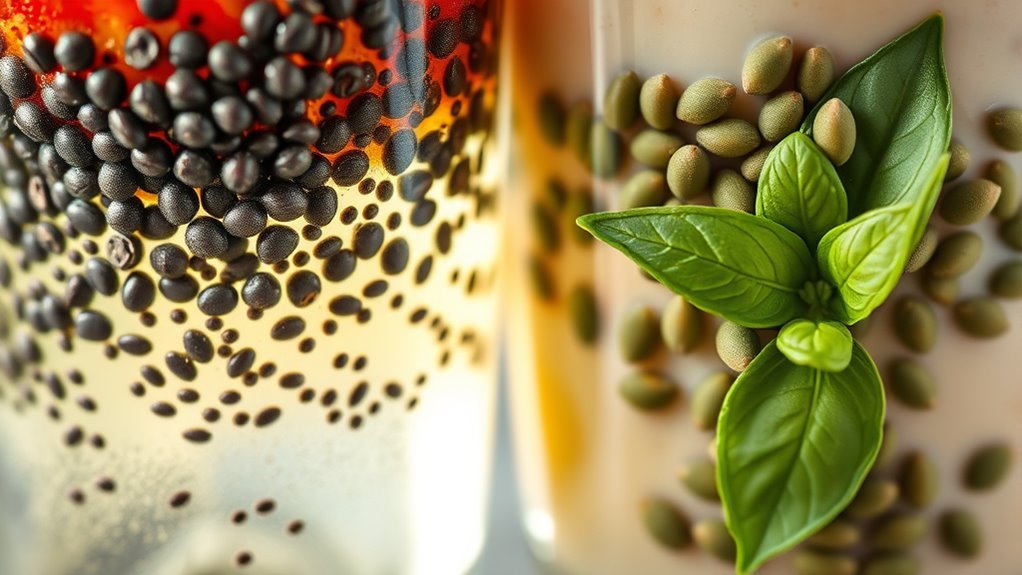
When choosing between chia and basil seeds, understanding their unique nutritional profiles and health benefits can help you make an informed decision. Both seeds bring valuable qualities to your drinks and desserts, but they serve different purposes in regards to nutrition and culinary application. Chia seeds are celebrated for their high nutritional benefits, packing a significant amount of omega-3 fatty acids, fiber, protein, and minerals like calcium, magnesium, and phosphorus. These nutrients support heart health, aid digestion, and help maintain energy levels. Basil seeds, on the other hand, are rich in mucilage, a natural thickening agent, and contain vitamins and minerals like vitamin K, iron, and calcium. While they don’t boast the same omega-3 content as chia, basil seeds offer unique benefits, especially for hydration and soothing digestion.
Both seeds require proper preparation and storage to maximize their health benefits, and understanding their storage guidelines can help preserve their freshness and nutritional value. Culinary uses are another key distinction. Chia seeds are incredibly versatile; you can soak them in liquids to create gel-like textures perfect for puddings, smoothies, or to thicken drinks. Their mild flavor blends seamlessly into a variety of recipes, making them a popular choice for health-conscious desserts and beverages. Basil seeds, often called sabja or tukmaria, are prized for their ability to absorb liquids and swell up into a jelly-like consistency. You’ll find them frequently used in traditional drinks like falooda or flavored milk, where their soothing, slightly herbal flavor adds an invigorating note. In desserts, basil seeds are often added to ice creams, puddings, or jellies, offering a unique texture and visual appeal.
When incorporating these seeds into drinks and desserts, consider their different behaviors and benefits. Chia seeds tend to stay crunchy until soaked, providing a chewy texture, while basil seeds quickly swell and develop a gel-like coating. If you’re after a nutritional boost, chia seeds are generally the better choice due to their dense nutrient profile. For a cooling, soothing effect in drinks or a visually appealing garnish in desserts, basil seeds excel, especially in hot weather or traditional recipes. Both seeds are easy to prepare; just soak them in water or milk until they reach the desired consistency. Remember, their unique properties can enhance your recipes, but understanding their differences ensures you choose the right seed for your culinary intent and health goals.
Frequently Asked Questions
How Do Chia and Basil Seeds Affect Blood Sugar Levels?
When you consume chia or basil seeds, they can influence your blood sugar impact by slowing digestion and carbohydrate absorption. This process helps stabilize your insulin response, preventing sharp spikes in blood sugar levels. Chia seeds are high in fiber, which supports steady blood sugar, while basil seeds also contain mucilage that can help manage glucose levels. Including these seeds in your diet may promote balanced blood sugar control and better overall health.
Can Chia or Basil Seeds Cause Allergic Reactions?
You might think seed allergies are rare, but they can be more common than you imagine! Chia and basil seeds could trigger allergic reactions if you have a seed allergy or experience cross reactivity with other seeds. Always check for symptoms like itching, swelling, or difficulty breathing. If you notice any signs, stop consuming immediately and consult a healthcare professional. Better safe than sorry with seed allergies!
Are There Any Nutritional Differences Between Organic and Non-Organic Seeds?
You might wonder if organic seeds differ nutritionally from non-organic ones. Organic farming avoids synthetic pesticides and fertilizers, reducing pesticide residues on the seeds. While nutrient content can be similar, organic seeds often have fewer chemical residues and may contain higher levels of antioxidants due to natural farming practices. Choosing organic supports environmentally friendly methods and reduces your exposure to potential pesticide residues, making it a better choice for health-conscious consumers.
How Long Can Soaked Chia or Basil Seeds Be Stored Safely?
You might think soaked seeds last forever, but their storage duration isn’t endless. Generally, soaked chia or basil seeds stay safe for about 5 to 7 days if stored properly. Keep them in an airtight container in the refrigerator, and always check for signs of spoilage like sour smell or mold. For the best freshness and safety, follow refrigeration tips and consume within this timeframe.
Do Chia and Basil Seeds Have Different Effects on Hydration?
You’ll notice that chia and basil seeds both impact hydration differently. Chia seeds have higher absorption rates, so they swell more and hold onto water longer, providing sustained hydration. Basil seeds absorb water more slowly and don’t swell as much, offering a milder hydration effect. The hydration impact depends on seed absorption rates, with chia being more effective for prolonged moisture retention, while basil seeds give a gentler, quicker hydration boost.
Conclusion
So, next time you’re faced with the dazzling choice between chia and basil seeds, remember—they’re basically the celebrity duos of your drinks and desserts. One’s the trendy hipster, the other’s the classic old-timer. Whether you want to impress or just confuse your taste buds, you now hold the secret to their sneaky differences. Now go ahead, sprinkle away—just don’t be surprised if your friends start questioning your seed IQ!
